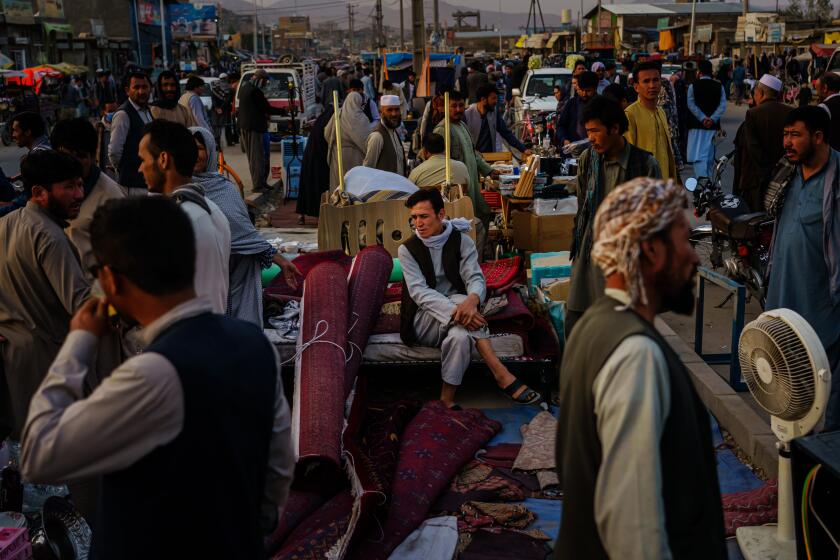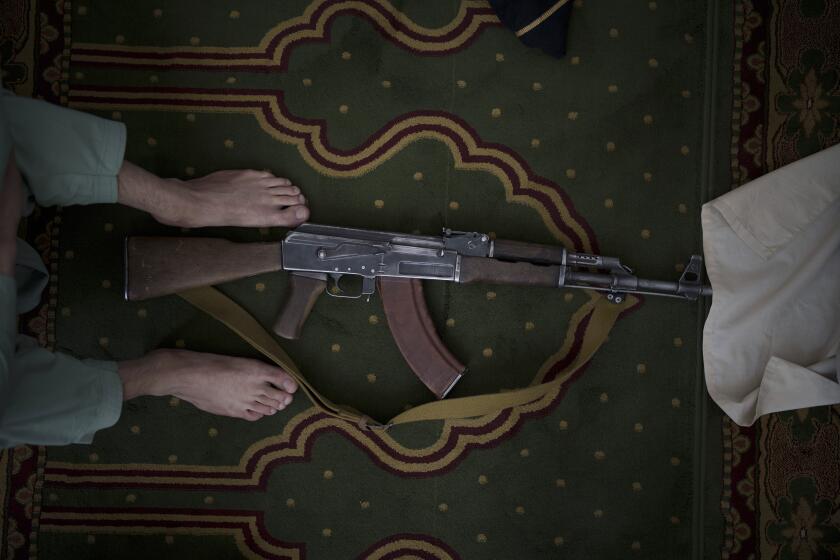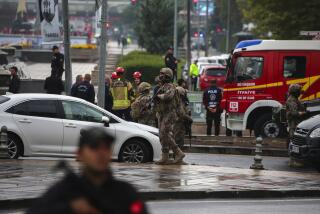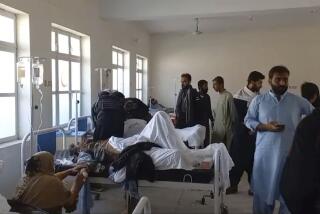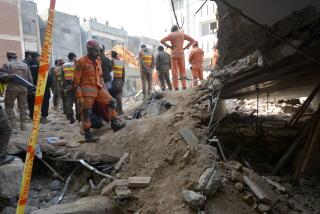Islamic State claims responsibility for Afghan mosque blast that killed at least 46

At least 46 people were killed in an explosion targeting a Shiite Muslim mosque in Kunduz, Afghanistan, a Taliban police official says.
- Share via
KABUL, Afghanistan — An Islamic State suicide bomber struck a mosque packed with Shiite Muslim worshipers in northern Afghanistan on Friday, killing at least 46 people and wounding dozens in the latest security challenge to the Taliban as it transitions from insurgency to governance.
In its claim of responsibility, the region’s Islamic State affiliate identified the bomber as a Uyghur Muslim, saying the attack targeted both Shiites and the Taliban for their purported willingness to expel Uyghurs to meet demands from China. The statement was carried by the Islamic State-linked Aamaq news agency.
The blast tore through a crowded mosque in the city of Kunduz during noon prayers, the highlight of the Muslim religious week. It was the latest in a series of Islamic State bombings and shootings that have targeted Afghanistan’s new Taliban rulers, as well as religious institutions and minority Shiites, since U.S. and NATO troops left in August.
The blast blew out windows, charred the ceiling and scattered debris and twisted metal across the floor. Rescuers carried one body out on a stretcher and another in a blanket. Bloodstains covered the front steps.
A resident of the area, Hussaindad Rezayee, said he rushed to the mosque when he heard the explosion, just as prayers started. “I came to look for my relatives. The mosque was full,” he said.
Restless Kabul residents ponder what remains and what changes in the Afghan capital after more than a month of Taliban rule.
The worshipers targeted Friday were Hazaras, who have long suffered from double discrimination as an ethnic minority and as followers of Shiite Islam in a majority-Sunni country.
The Islamic State group and the Taliban, which seized control of the country with the exit of the foreign troops, are strategic rivals. Islamic State militants have targeted Taliban positions and attempted to recruit members from their ranks.
In the past, the Taliban managed to contain the Islamic State threat in tandem with U.S. and Afghan airstrikes. Without these, it remains unclear whether the Taliban can suppress what appears to be a growing Islamic State footprint. The militants, once confined to the east, have penetrated the capital of Kabul and other provinces with new attacks.
This comes at a critical moment, as the Taliban attempts to consolidate power and transform its guerrilla fighters into a structured police and security force. But while the group attempts to project an air of authority through reports of raids and arrests of Islamic State members, it remains unclear whether it has the capability to protect soft targets, including religious institutions.
The Biden administration condemned Friday’s attack. “The Afghan people deserve a future free of terror,” State Department spokesman Ned Price said in a statement.
In Kunduz, police officials were still working the scene Friday at the Gozar-e-Sayed Abad Mosque. Taliban spokesman Bilal Karimi told the Associated Press that 46 worshipers were killed and 143 wounded in the explosion. He said an investigation was underway.
The death toll of 46 is the highest in an attack since foreign troops left Afghanistan.
Amnesty International says 13 ethnic Hazaras, most of them soldiers in the Afghan army who had surrendered to the Taliban, were killed Aug. 30.
The United Nations mission in Afghanistan condemned Friday’s attack, saying it was “part of a disturbing pattern of violence” targeting religious institutions.
A prominent Shiite cleric, Sayed Hussain Alimi Balkhi, called on the Taliban to provide security for the Shiites of Afghanistan. “We expect the security forces of the government to provide security for the mosques since they collected the weapons that were provided for the security of the worship places,” he said.
Dost Mohammad Obaida, the deputy police chief in Kunduz, pledged to protect minorities in the province. “I assure our Shiite brothers that the Taliban are prepared to ensure their safety,” he said.
News Alerts
Get breaking news, investigations, analysis and more signature journalism from the Los Angeles Times in your inbox.
You may occasionally receive promotional content from the Los Angeles Times.
The new tone struck by the Taliban, at least in Kunduz, is in sharp contrast to the well-documented history of Taliban fighters committing a litany of atrocities against minorities, including Hazaras. The Taliban, now feeling the weight of governing, employed tactics similar to Islamic State’s during its 20-year insurgency, including suicide bombings and shooting ambushes.
And it has not halted attacks on Hazaras.
This week, a report by Amnesty International found the Taliban unlawfully killed 13 Hazaras, including a 17-year-old girl, in Daykundi province, after members of the security forces of the former government surrendered.
In Kunduz province, Hazaras make up about 6% of the province’s population of nearly 1 million people. The province also has a large ethnic Uzbek population that has been targeted for recruitment by Islamic State, which is closely aligned with the militant Islamic Movement of Uzbekistan.
Friday’s attack was the third in a week to target a place of worship or religious study.
Islamic State has also claimed two deadly bombings in Kabul, including the Aug. 26 bombing that killed at least 169 Afghans and 13 U.S. military personnel outside the Kabul airport in the final days of the American pullout from Afghanistan.
Islamic State also claimed responsibility for a bombing Sunday outside Kabul’s Eid Gah Mosque that killed at least five civilians. A madrassa, or religious school, was attacked in Khost province on Wednesday by unknown assailants.
The series of attacks claimed by Islamic State are also a worrying sign for Afghanistan’s Central Asian neighbors and Russia, which has been courting the Taliban for years as an ally against the creeping Islamic State role in the region.
Akhgar reported from Istanbul, Turkey. Associated Press writers Kathy Gannon in Islamabad, Pakistan, and Sarah El Deeb in Beirut contributed to this report.
More to Read
Sign up for Essential California
The most important California stories and recommendations in your inbox every morning.
You may occasionally receive promotional content from the Los Angeles Times.
